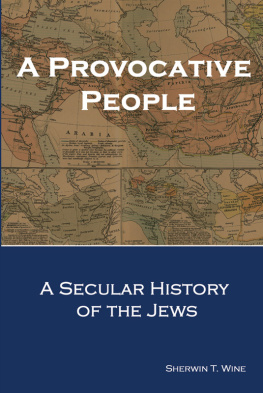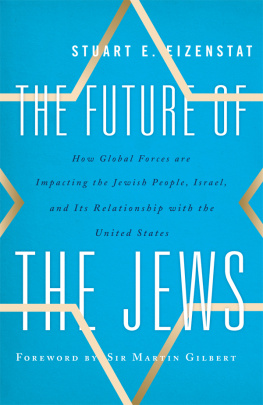

A publication of the International Institute for Secular Humanistic Judaism and The Milan Press
Copyright 2012
International Institute for Secular Humanistic Judaism
North American Section.
28611 West Twelve Mile Road
Farmington Hills, Michigan 48334
All rights reserved.
No portion of this book may be reproduced or utilized in any form or by any means without written permission from the publisher. The only exception to this prohibition is fair use as defined by U.S. copyright law.
Manufactured in the United States of America
E-book ISBN: 978-0-9858778-1-1
TABLE OF CONTENTS
The Jews did not begin with Abraham. Their foundation lies in the ancient cultures of the Near East. The story of Egypt, Sumeria, Babylonia, the Amorites and the Canaanites is also the story of the Jews. Jewish culture when it began was already a composite of the legacy of these older civilizations.
The Jews did not emerge as a nation under the leadership of Moses. They were never rescued from slavery in Egypt. They never stopped at Sinai. Two Hebrew nations emerged in the highlands of Canaan. One was Israel; the other was Judah. The relationship of the two nations was often hostile. The Israelites were more powerful than the Judeans (Jews). Omri and Ahab were greater kings than David and Solomon. But Israel was destroyed by the Assyrians. Only the Jews survived.
The religion of the Jews was dramatically altered by the victory of the Assyrians. An informal religious rebellioncalled here the Protest Movement and led by the prophets of a god named Yahwehoverthrew the religious establishment and elevated Yahweh to be the supreme ruler of the universe. Out of this rebellion emerged exclusive worship of Yahweh and hostility to the cults of other gods, which together transformed the Jews into a segregated and provocative people. After the destruction of the Jerusalem Temple by the Chaldeans and the elimination of the monarchy, Judah became a theocracy dominated by Yahweh priests and by the book (Torah) they created which enforced their authority.
The conquest of Judah by both the Persians and the Greeks led to the dispersion of the Jews. The dispersion facilitated the beginnings of the economic transformation of the Jews from an agricultural to a commercial people. The culture of the Greeks was especially provocative, dividing the Jews into Hellenists and anti-Hellenists. For a short time, the Jews regained their independence under the Maccabees. But the coming of the Romans ended national autonomy and led to a fierce struggle among rival religious sects for the allegiance of the Jews.
An anti-Hellenist religious sect called the Pharisees emerged as the supreme national authority after the destruction of the second Jerusalem Temple by the Romans. The Pharisees were led by the rabbis, who replaced the Zadokite priests as the chief figures in a new theocracy. The rabbis championed a new salvation religion which was highly popular. They reinforced their authority by finalizing the scriptures of the First Torah (Bible) and introducing a Second Torah (Talmud). However, the Roman overlords and most of the nations of the Roman Empire were converted to a competing salvation religion (Christianity), which was derived from Rabbinic Judaism but which did not require membership in the Jewish nation. The Christian victors turned against the Jews.
Because of Christian persecution, the division of the Jews into an Eastern Diaspora (Persia) and a Western Diaspora (Rome) was accelerated. Most of the Jews of the world ended up in the Eastern Diaspora. When the Eastern Empire was conquered by the Muslim Arabs, Islam became the cultural setting of the Eastern Jews. As the Arabs were united under a central authority (Caliph) so were the Jews (Exilarch). Out of this centralization, Rabbinic Judaism was finalized as an orthodoxy. Because of Turkish invasions, Spain replaced Iraq as the center of the Muslim Jewish world. In time Turkey took the place of Spain as Muslim power declined.
The Jews who remained in the Western Diaspora coped with the hostility of Christian rulers and Christian clergy. Jews survived because they performed certain commercial functions which no other established groups were willing or able to do. The Jews followed their commercial fortunes from Greece to Italy to Germany (Ashkenaz)and ultimately to Poland. As Christians became willing to perform these economic functions, Jewish fortunes declined. Mystical religion (Kabbalah/Hasidism) became the comfort of the downtrodden. The conquest of Poland by the Russians added to the distress.
After 2200 years of domination by religion and the clergy, the Jews of the Western Diaspora were transformed into a secular people by the twin revolutions of capitalism and science. Many Jews became the stars of this post-Christian world and achieved unprecedented economic and intellectual success. But the old religion no longer fit a secular people. Reform Judaism, both conservative and radical, became the first major attempt to confront this problem of Jewish identity.
The trauma of overwhelming change triggered a new antisemitism which was secular. The provocation of imagined power replaced the provocation of religious difference. The demonization of the Jew undermined Jewish safety in both Eastern and Western Europe. Jewish responses to this assault were often secular. Secular nationalism (Yiddishist and Zionist), secular socialism (Menshevik and Bolshevik) and emigration to America reshaped Jewish life. The twin traumas of antisemitic Stalinism and the Nazi Holocaust decimated Jewish ranks. America and Zionist Israel emerged as the new centers of Jewish life.
In the last century, Jewish life has been dominated by Jewish nationalism and the new state of Israel. American Jewish power was mobilized to support the Zionist agenda. American Jewish culture was revived by the enthusiasm that Zionism engendered. Given all the social and liberation transformations of the twentieth century, Judaism and the Jewish religion featured the emergence of many new philosophic and religious experiments which sought to arrange for Jewish Diaspora survival. But the relentless global revolution resisted Zionism and its agenda of normalizing the Jews. A substantial Israeli Diaspora has now emerged to reinforce the age-old reality of the Jews as a world people. Perhaps the idea of a nation that is a world people is a unique positive contribution of the Jews to the world.
AFTERWORDHumanistic Judaism and Sherwin Wine:
An Appreciation by Adam Chalom
FOREWORD
Born in 1928, Sherwin Wine was the founder of the Humanistic Jewish movement. Ordained a Reform rabbi at the Hebrew Union College in Cincinnati, Ohio, he was the first rabbi of the Birmingham Temple in suburban Detroit, Michigan. In 1965 Humanistic Judaism emerged when the Birmingham Temple began to publicize its philosophy of Judaism. In 1966 a special committee for Humanistic Judaism was established at the Temple to disseminate service and educational material with rabbis and laity throughout the United States. The following year the movement issued a statement affirming that Judaism should be governed by empirical reason and human needs. In 1969 the Society for Humanistic Judasim was founded in Detroit, and the next year the first annual conference of the Society took place.
During the next ten years new congregations were established in Boston, Toronto, Los Angeles, Washington, Miami, Long Beach and Huntington, New York. In subsequent years Secular Humanistic Judaism under Wines leadership became an international organization with supporters on five continents.
Next page










